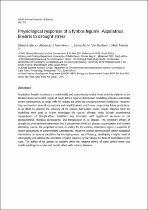 ResearchSpace
ResearchSpace
Physiological responses of a fynbos legume, Aspalathus linearis to drought stress
JavaScript is disabled for your browser. Some features of this site may not work without it.
- ResearchSpace
- →
- Research Publications/Outputs
- →
- Journal Articles
- →
- View Item
| dc.contributor.author |
Lotter, D

|
|
| dc.contributor.author |
Valentine, AJ

|
|
| dc.contributor.author |
Van Garderen, EA

|
|
| dc.contributor.author |
Tadross, M

|
|
| dc.date.accessioned | 2015-03-12T10:27:47Z | |
| dc.date.available | 2015-03-12T10:27:47Z | |
| dc.date.issued | 2014-07 | |
| dc.identifier.citation | Lotter, D, Valentine, A.J, Van Garderen, E.A and Tadross, M. 2014. Physiological responses of a fynbos legume, Aspalathus linearis to drought stress. South African Journal of Botany, vol. 94, pp 218-223 | en_US |
| dc.identifier.issn | 0254-6299 | |
| dc.identifier.uri | http://ac.els-cdn.com/S0254629914001355/1-s2.0-S0254629914001355-main.pdf?_tid=ca239906-b694-11e4-98b6-00000aacb35e&acdnat=1424171269_ff78ef52343784dd99998757da309173 | |
| dc.identifier.uri | http://hdl.handle.net/10204/7958 | |
| dc.description | Due to copyright restrictions, the attached PDF file only contains the abstract of the full text item. For access to the full text item, please consult the publisher's website. | en_US |
| dc.description.abstract | Aspalathus linearis (rooibos) is a medicinally and economically useful shrub which is endemic to the Mediterranean west coast region of South Africa. Species distribution modelling indicates potentially severe consequences in range shift for rooibos tea under the changing climate conditions. However, they are based on several assumptions and simplifications which may compromise future predictions. In an effort to improve the accuracy of the species distribution model, results obtained from the modelling were used to further investigate the species' climatic limits through experimental manipulation of drought.Water limitation was associated with significant decreases in net photosynthesis, stomatal conductance, and transpiration in A. linearis. The inhibitory effects of drought on photosynthetic parameters had a concomitant effect on biomass accumulation and nutrient allocation. Hence, the projected increase in aridity for the rooibos production region is expected to reduce productivity of commercially cultivated tea. However, rooibos demonstrated certain adaptation mechanisms to adverse conditions by increasing water use efficiency, developing a higher level of sclerophylly and altering the allocation of plant reserves by increasing the flow of assimilates to the roots. The ability of the species to partially offset the negative effects of water deficit stress may enable seedlings to survive and persist, albeit with reduced biomass. | en_US |
| dc.language.iso | en | en_US |
| dc.publisher | Elsevier | en_US |
| dc.relation.ispartofseries | Workflow;14094 | |
| dc.subject | Aspalathus linearis | en_US |
| dc.subject | Drought stress | en_US |
| dc.subject | Photosynthesis | en_US |
| dc.subject | Biomass allocation | en_US |
| dc.subject | Nutrient allocation | en_US |
| dc.title | Physiological responses of a fynbos legume, Aspalathus linearis to drought stress | en_US |
| dc.type | Article | en_US |
| dc.identifier.apacitation | Lotter, D., Valentine, A., Van Garderen, E., & Tadross, M. (2014). Physiological responses of a fynbos legume, Aspalathus linearis to drought stress. http://hdl.handle.net/10204/7958 | en_ZA |
| dc.identifier.chicagocitation | Lotter, D, AJ Valentine, EA Van Garderen, and M Tadross "Physiological responses of a fynbos legume, Aspalathus linearis to drought stress." (2014) http://hdl.handle.net/10204/7958 | en_ZA |
| dc.identifier.vancouvercitation | Lotter D, Valentine A, Van Garderen E, Tadross M. Physiological responses of a fynbos legume, Aspalathus linearis to drought stress. 2014; http://hdl.handle.net/10204/7958. | en_ZA |
| dc.identifier.ris | TY - Article AU - Lotter, D AU - Valentine, AJ AU - Van Garderen, EA AU - Tadross, M AB - Aspalathus linearis (rooibos) is a medicinally and economically useful shrub which is endemic to the Mediterranean west coast region of South Africa. Species distribution modelling indicates potentially severe consequences in range shift for rooibos tea under the changing climate conditions. However, they are based on several assumptions and simplifications which may compromise future predictions. In an effort to improve the accuracy of the species distribution model, results obtained from the modelling were used to further investigate the species' climatic limits through experimental manipulation of drought.Water limitation was associated with significant decreases in net photosynthesis, stomatal conductance, and transpiration in A. linearis. The inhibitory effects of drought on photosynthetic parameters had a concomitant effect on biomass accumulation and nutrient allocation. Hence, the projected increase in aridity for the rooibos production region is expected to reduce productivity of commercially cultivated tea. However, rooibos demonstrated certain adaptation mechanisms to adverse conditions by increasing water use efficiency, developing a higher level of sclerophylly and altering the allocation of plant reserves by increasing the flow of assimilates to the roots. The ability of the species to partially offset the negative effects of water deficit stress may enable seedlings to survive and persist, albeit with reduced biomass. DA - 2014-07 DB - ResearchSpace DP - CSIR KW - Aspalathus linearis KW - Drought stress KW - Photosynthesis KW - Biomass allocation KW - Nutrient allocation LK - https://researchspace.csir.co.za PY - 2014 SM - 0254-6299 T1 - Physiological responses of a fynbos legume, Aspalathus linearis to drought stress TI - Physiological responses of a fynbos legume, Aspalathus linearis to drought stress UR - http://hdl.handle.net/10204/7958 ER - | en_ZA |





